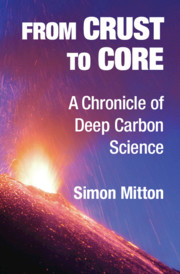Book contents
- From Crust to Core
- From Crust to Core
- Copyright page
- Dedication
- Contents
- Foreword
- Acknowledgments
- Introduction
- 1 Why Carbon in Earth Matters
- 2 The Origin of Deep Carbon in Deep Space
- 3 Deliveries of Cosmic Carbon Continue
- 4 On the Nature of Earth’s Interior
- 5 Earth’s Physical Interior Revealed
- 6 Thousands, Millions or Billions
- 7 Physics and Chemistry of Deep Earth
- 8 Confronting the Continental Drift Conundrum
- 9 The Mid-Atlantic Ridge and Rift Valley
- 10 Earth’s Deep Dynamics Discovered
- 11 Reversals of Fortune
- 12 Deep Carbon
- 13 Carbon-Bearing Phases in the Mantle
- 14 Diamond in the Mantle
- 15 Deep Life
- Glossary
- Biographical Notes
- Index
- References
4 - On the Nature of Earth’s Interior
Published online by Cambridge University Press: 19 December 2020
- From Crust to Core
- From Crust to Core
- Copyright page
- Dedication
- Contents
- Foreword
- Acknowledgments
- Introduction
- 1 Why Carbon in Earth Matters
- 2 The Origin of Deep Carbon in Deep Space
- 3 Deliveries of Cosmic Carbon Continue
- 4 On the Nature of Earth’s Interior
- 5 Earth’s Physical Interior Revealed
- 6 Thousands, Millions or Billions
- 7 Physics and Chemistry of Deep Earth
- 8 Confronting the Continental Drift Conundrum
- 9 The Mid-Atlantic Ridge and Rift Valley
- 10 Earth’s Deep Dynamics Discovered
- 11 Reversals of Fortune
- 12 Deep Carbon
- 13 Carbon-Bearing Phases in the Mantle
- 14 Diamond in the Mantle
- 15 Deep Life
- Glossary
- Biographical Notes
- Index
- References
Summary
Treating Earth as a system in which life plays an important role in controlling the environment is not new. In fact, speculation on how the physical and living elements of the Earth interact goes back to antiquity, and earlier, with deities capriciously intervening in the affairs of the human population. The notion of a single integrated system mediated by gods was the stuff of religion and legend. The Greek cosmologists dismissed arbitrary gods as controllers of the universe. Instead, they considered that the order of nature and the cosmos follows eternal cycles. Democritus (c. 460–370 BCE) proposed an atomist theory of matter that invoked an early form of the conservation of energy: atoms are in eternal motion. The Roman poet and philosopher Lucretius (96–55 BCE) drew on the atomic theory of Democritus to account for a variety of terrestrial phenomena, such as earthquakes and lightning, according to physical principles. Some Greek philosophers, including Thales (624–546 BCE), Anaximenes (585–528 BCE) and Heraclitus (535–475 BCE), taught a philosophical doctrine that there is a form of life in all matter. The rationalist philosophical styles of the ancient world were lost until the world of ideas was revived in Europe in the fifteenth century by the rise of humanism in Italy.
- Type
- Chapter
- Information
- From Crust to CoreA Chronicle of Deep Carbon Science, pp. 62 - 76Publisher: Cambridge University PressPrint publication year: 2020



